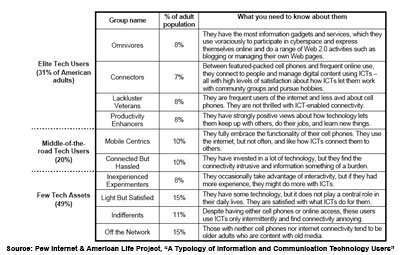Notes on new Pew research: Designing for the other 69 percent, and more

The Pew Internet & American Life Project has a valuable new report, A Typology of Information and Communication Technology Users, that weighs in at 65 pages. For those of you interested in the condensed version, here are my notes on the report.
When we talk about Web 2.0 here and elsewhere in the 2-dot-O-sphere, there is a tendency to For a lot of people, Web 2.0 looks like too much work.forget that many people don't understand or don't want to become more active participants in networked exchanges. It looks like a lot of work to them. These same people think computers are primarily troublesome and, if we acknowledge their right to think what they want, they are often correct. So, how do we build tools that make folks want to engage?
The most important takeaway from the research is to recognize about tech users is that the leading edge, who eagerly adopt new services, such as social networking, and devices, represent just eight percent of the market. Another 23 percent, which the Pew Project authors characterize as "Connectors," "Lackluster Veterans," and "Productivity Enhancers," are engaged but not necessarily enthusiastic about the tools they use, while the remaining 69 percent of Americans surveyed fall into categories that don't deeply value networked services as a vehicle for self-expression or are part of the 15 percent of people who simply don't have access to the network. The chart at the left shows the breakdown and a brief explanation of each type of user as defined by the Pew Project. For a full-sized view of the chart, click here.
Let's focus on the omnivores, the eight percent of "American adults [that] constitute the most active participants in the information society." These are people who do much more than surf the Web for information, something that is typical of many Americans today. Instead, Omnivores see the Web as the logical extension of their television, radio and newspaper, as well as seeing the network as a platform for personal expression.
When we talk about the social network, we're talking about the environment peopled by Omnivores and "Connectors," the seven percent "of the adult population that surround themselves with technology and use it to connect with people and digital content. Social interaction is implicit in these two groups' Net usage, because they modify as well as consume. Some create Web pages, others create blogs and lists or calendars or other frames for information that create context for their friends, family and colleagues. In short, the top 15 percent of network users are the storytellers shaping the narrative that makes social networking relevant to themselves and everyone else.
Unfortunately, technologists often design tools without thinking about the user's ability to let some of themselves rub off on the data used. Social tagging, Digging, and other systems that require a user to add their little snippet of context to content are the natural and pleasing tools that collect metadata without raising the usage bar too high. Simplicity and purpose define what succeeds in social systems, while tools that simply demand more information from the user are doomed, because they stress these top-15-percenters and annoy virtually everyone else.
Indeed, the next group identified by the Pew Project, "Lackluster Veterans," are already pretty tired of the demands of technology. This group, another eight percent of American adults, "are not at all passionate about their abundance of modern ICTs [information and communications technologies]. Few like the intrusiveness their gadgets add to their lives and not many see ICTs adding to their personal productivity." Even the next eight percent, known as "Productivity Enhancers," are reluctant contributors to social networking systems, because their Internet usage is primarily focused on harvesting value from systems rather than contributing to those systems.
The Pew Project categorizes the remaining 69 percent as ranging from active mobile phone users who don't see much use in network services that require significant effort to the hassled and inexperienced users who endure new tools, avoiding them to the greatest extent possible, and the very large (26 percent) group of adults that use the Net but couldn't be called excited about it to the mainly elderly 15 percent that are largely offline.
We still haven't answered the question about what makes a social site more attractive. However, I've hinted at my belief that narrative is the essential ingredient. We'll look more deeply at the Pew Research to see where users say they will follow a tool with a good story to tell or that tells a good story in the next installment.